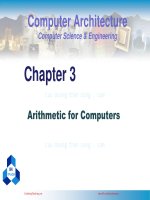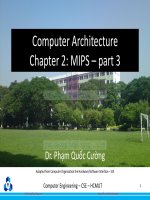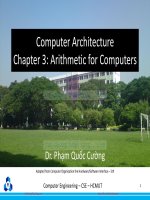kiến trúc máy tính phạm minh cường chương ter4 part1 the processorsinhvienzone com
Bạn đang xem bản rút gọn của tài liệu. Xem và tải ngay bản đầy đủ của tài liệu tại đây (3.57 MB, 51 trang )
Computer Architecture
Chapter 4: The Processor Part 1
Dr. Phạm Quốc Cường
Adapted from Computer Organization the Hardware/Software Interface – 5th
Computer Engineering – CSE – HCMUT
CuuDuongThanCong.com
/>
1
Introduction
• CPU performance factors
– Instruction count
• Determined by ISA and compiler
– CPI and Cycle time
• Determined by CPU hardware
• We will examine two MIPS implementations
– A simplified version
– A more realistic pipelined version
• Simple subset, shows most aspects
– Memory reference: lw, sw
– Arithmetic/logical: add, sub, and, or, slt
– Control transfer: beq, j
Chapter 4 — The Processor — 2
CuuDuongThanCong.com
/>
Instruction Execution
• PC instruction memory, fetch instruction
• Register numbers register file, read registers
• Depending on instruction class
– Use ALU to calculate
• Arithmetic result
• Memory address for load/store
• Branch target address
– Access data memory for load/store
– PC target address or PC + 4
Chapter 4 — The Processor — 3
CuuDuongThanCong.com
/>
CPU Overview
Chapter 4 — The Processor — 4
CuuDuongThanCong.com
/>
Execution Model
• Instruction fetch: PC instruction address
• Instruction decode: register operands register
file
• Instruction execute:
– Load/store: compute a memory address
– Arithmetic: compute an arithmetic result
• Write back:
– Load/store: store a value to a register or a memory
location
– Arithmetic: store a result of register file
5
CuuDuongThanCong.com
/>
Multiplexers
Can’t just join
wires together
Use multiplexers
Chapter 4 — The Processor — 6
CuuDuongThanCong.com
/>
Multiplexer
𝐶 = 𝐴𝑆 + 𝐵𝑆
7
CuuDuongThanCong.com
/>
Control vs. Data signals
• Control signal: used for
multiplexer selection or
for directing the
operation of a
functional unit
• Data signal: contains
information that is
operated on by a
functional unit
8
CuuDuongThanCong.com
/>
Control
Chapter 4 — The Processor — 9
CuuDuongThanCong.com
/>
Logic Design Basics
• Information encoded in binary
– Low voltage = 0, High voltage = 1
– One wire per bit
– Multi-bit data encoded on multi-wire buses
• Combinational element
– Operate on data
– Output is a function of input
• State (sequential) elements
– Store information
Chapter 4 — The Processor — 10
CuuDuongThanCong.com
/>
Combinational Elements
• AND-gate
• Adder
– Y=A&B
A
B
– Y=A+B
Y
A
+
Y
B
• Multiplexer
• Arithmetic/Logic Unit
– Y = S ? I1 : I0
– Y = F(A,B)
A
I0
I1
M
u
x
ALU
Y
Y
B
F
S
Chapter 4 — The Processor — 11
CuuDuongThanCong.com
/>
Sequential Elements
• Register: stores data in a circuit
– Uses a clock signal to determine when to update
the stored value
– Edge-triggered: update when Clk changes from 0
to 1
Clk
D
Q
Clk
D
Q
Chapter 4 — The Processor — 12
CuuDuongThanCong.com
/>
Sequential Elements
• Register with write control
– Only updates on clock edge when write control
input is 1
– Used when stored value is required later
Clk
D
Q
Write
Clk
Write
D
Q
Chapter 4 — The Processor — 13
CuuDuongThanCong.com
/>
Clocking Methodology
• Combinational logic transforms data during
clock cycles
– Between clock edges
– Input from state elements (a memory or a
register), output to state element
– Longest delay determines clock period
Chapter 4 — The Processor — 14
CuuDuongThanCong.com
/>
Building a Datapath
• Datapath
– Elements that process data and addresses
in the CPU
• Registers, ALUs, mux’s, memories, …
• We will build a MIPS datapath incrementally
– Refining the overview design
Chapter 4 — The Processor — 15
CuuDuongThanCong.com
/>
Instruction Fetch
Increment by
4 for next
instruction
32-bit
register
Chapter 4 — The Processor — 16
CuuDuongThanCong.com
/>
R-Format Instructions
• Read two register operands
• Perform arithmetic/logical operation
• Write register result
Chapter 4 — The Processor — 17
CuuDuongThanCong.com
/>
Load/Store Instructions
• Read register operands
• Calculate address using 16-bit offset
– Use ALU, but sign-extend offset
• Load: Read memory and update register
• Store: Write register value to memory
Chapter 4 — The Processor — 18
CuuDuongThanCong.com
/>
Branch Instructions
• Read register operands
• Compare operands
– Use ALU, subtract and check Zero output
• Calculate target address
– Sign-extend displacement
– Shift left 2 places (word displacement)
– Add to PC + 4
• Already calculated by instruction fetch
Chapter 4 — The Processor — 19
CuuDuongThanCong.com
/>
Branch Instructions
Just
re-routes
wires
Sign-bit wire
replicated
Chapter 4 — The Processor — 20
CuuDuongThanCong.com
/>
Composing the Elements
• First-cut data path does an instruction in one
clock cycle
– Each datapath element can only do one function
at a time
– Hence, we need separate instruction and data
memories
• Use multiplexers where alternate data sources
are used for different instructions
Chapter 4 — The Processor — 21
CuuDuongThanCong.com
/>
R-Type/Load/Store Datapath
Chapter 4 — The Processor — 22
CuuDuongThanCong.com
/>
Full Datapath
Chapter 4 — The Processor — 23
CuuDuongThanCong.com
/>
ALU Control
• ALU used for
– Load/Store: F = add
– Branch: F = subtract
– R-type: F depends on funct field
ALU control
Function
0000
AND
0001
OR
0010
add
0110
subtract
0111
set-on-less-than
1100
NOR
CuuDuongThanCong.com
/>
ALU Control
• Assume 2-bit ALUOp derived from opcode
– Combinational logic derives ALU control
opcode
ALUOp
Operation
funct
ALU function
lw
00
load word
XXXXXX
add
0010
sw
00
store word
XXXXXX
add
0010
beq
01
branch equal
XXXXXX
subtract
0110
R-type
10
add
100000
add
0010
subtract
100010
subtract
0110
AND
100100
AND
0000
OR
100101
OR
0001
set-on-less-than
101010
set-on-less-than
0111
Chapter 4 — The Processor — 25
CuuDuongThanCong.com
/>
ALU control









